
A cell having an emf $\varepsilon $ and internal resistance $r$ is connected across a variable external resistance $R$. As the resistance $R$ is increased, the plot of potential difference $V$ across $R$ is given by-
(A)
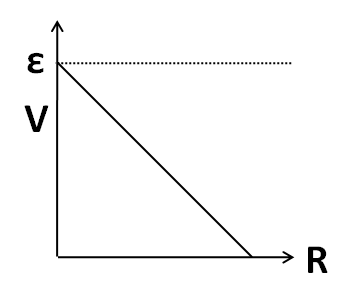
(B)
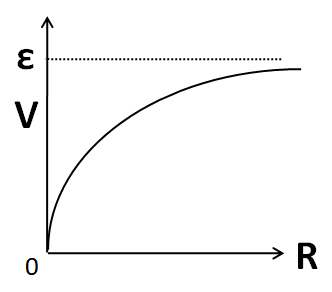
(C)
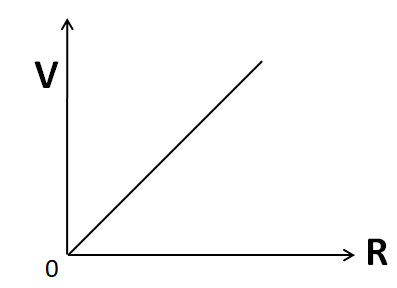
(D)
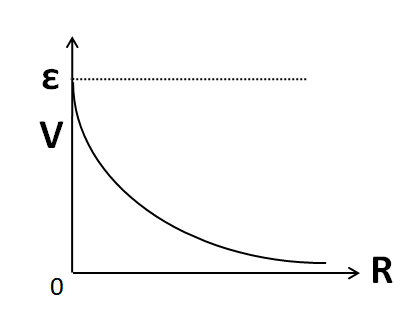




Answer
218.4k+ views
Hint: To solve this question, we need to draw the circuit diagram according to the given information. Then using the Ohm’s law we can find out the expression for the potential difference across the external resistor in terms of the external resistance. From there we can predict the shape of the graph.
Complete step-by-step solution:
According to the information given in the question, a cell of emf $\varepsilon $ and internal resistance $r$ is connected across a variable external resistance $R$. So we can represent this information by the circuit diagram shown below.
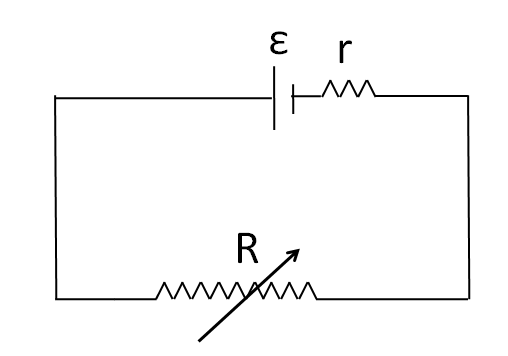
Let the current in the circuit be $I$. The internal resistance and the external resistance are connected in series combination with each other. So the net resistance in the circuit is
${R_N} = R + r$ ……………………...(1)
From the Ohm’s law we can write
$\varepsilon = I{R_N}$
From (1)
$\varepsilon = I\left( {R + r} \right)$
$ \Rightarrow I = \dfrac{\varepsilon }{{R + r}}$................(2)
Now, the potential difference across the resistance is given by the Ohm’s law as
$V = IR$
Substituting (2) we get
$V = \dfrac{{\varepsilon R}}{{R + r}}$..........................(3)
Since the independent variable $R$ is appearing at both the numerator and the denominator, so we have to simplify the above equation (3), which can also be written as
$V = \dfrac{{\varepsilon \left( {R + r - r} \right)}}{{R + r}}$
$V = \varepsilon - \dfrac{{\varepsilon r}}{{R + r}}$...............................(4)
So now we have the independent variable $R$ only in the denominator. Now, we substitute in (4) to get
$V\left( 0 \right) = \varepsilon - \dfrac{{\varepsilon r}}{{0 + r}}$
$ \Rightarrow V\left( 0 \right) = 0$
So for $R = 0$, we have $V = 0$. So the plot must pass through the origin. As we can see that the plots given in the options A and D do not pass through the origin, so they must be incorrect.
Therefore options A and D are incorrect.
Now, we take the limit $R \to \infty $ at both sides in (4) to get
$\mathop {\lim }\limits_{R \to \infty } V = \mathop {\lim }\limits_{R \to \infty } \left( {\varepsilon - \dfrac{{\varepsilon r}}{{R + r}}} \right)$
\[ \Rightarrow \mathop {\lim }\limits_{R \to \infty } V = \varepsilon - \varepsilon r\mathop {\lim }\limits_{R \to \infty } \left( {\dfrac{1}{{R + r}}} \right)\]
We know that $\mathop {\lim }\limits_{x \to \infty } \left( {\dfrac{1}{{x + k}}} \right) = 0$. Therefore we have
\[\mathop {\lim }\limits_{R \to \infty } V = \varepsilon - \varepsilon r\left( 0 \right)\]
\[ \Rightarrow \mathop {\lim }\limits_{R \to \infty } V = \varepsilon \]
So the ordinate of the plot will approach the value $\varepsilon $ as the variable resistance $R$ is infinitely increased.
In the plot shown in option B, we can see this happening.
Hence, the correct answer is option B.
Note: Do not try to obtain the plot by using transformations of the graph. Although we can obtain the plot by that method also, that would take much time and also chances of mistakes are huge. So after getting the equation, always guess the plot by substituting the end point values and taking the limits.
Complete step-by-step solution:
According to the information given in the question, a cell of emf $\varepsilon $ and internal resistance $r$ is connected across a variable external resistance $R$. So we can represent this information by the circuit diagram shown below.

Let the current in the circuit be $I$. The internal resistance and the external resistance are connected in series combination with each other. So the net resistance in the circuit is
${R_N} = R + r$ ……………………...(1)
From the Ohm’s law we can write
$\varepsilon = I{R_N}$
From (1)
$\varepsilon = I\left( {R + r} \right)$
$ \Rightarrow I = \dfrac{\varepsilon }{{R + r}}$................(2)
Now, the potential difference across the resistance is given by the Ohm’s law as
$V = IR$
Substituting (2) we get
$V = \dfrac{{\varepsilon R}}{{R + r}}$..........................(3)
Since the independent variable $R$ is appearing at both the numerator and the denominator, so we have to simplify the above equation (3), which can also be written as
$V = \dfrac{{\varepsilon \left( {R + r - r} \right)}}{{R + r}}$
$V = \varepsilon - \dfrac{{\varepsilon r}}{{R + r}}$...............................(4)
So now we have the independent variable $R$ only in the denominator. Now, we substitute in (4) to get
$V\left( 0 \right) = \varepsilon - \dfrac{{\varepsilon r}}{{0 + r}}$
$ \Rightarrow V\left( 0 \right) = 0$
So for $R = 0$, we have $V = 0$. So the plot must pass through the origin. As we can see that the plots given in the options A and D do not pass through the origin, so they must be incorrect.
Therefore options A and D are incorrect.
Now, we take the limit $R \to \infty $ at both sides in (4) to get
$\mathop {\lim }\limits_{R \to \infty } V = \mathop {\lim }\limits_{R \to \infty } \left( {\varepsilon - \dfrac{{\varepsilon r}}{{R + r}}} \right)$
\[ \Rightarrow \mathop {\lim }\limits_{R \to \infty } V = \varepsilon - \varepsilon r\mathop {\lim }\limits_{R \to \infty } \left( {\dfrac{1}{{R + r}}} \right)\]
We know that $\mathop {\lim }\limits_{x \to \infty } \left( {\dfrac{1}{{x + k}}} \right) = 0$. Therefore we have
\[\mathop {\lim }\limits_{R \to \infty } V = \varepsilon - \varepsilon r\left( 0 \right)\]
\[ \Rightarrow \mathop {\lim }\limits_{R \to \infty } V = \varepsilon \]
So the ordinate of the plot will approach the value $\varepsilon $ as the variable resistance $R$ is infinitely increased.
In the plot shown in option B, we can see this happening.
Hence, the correct answer is option B.
Note: Do not try to obtain the plot by using transformations of the graph. Although we can obtain the plot by that method also, that would take much time and also chances of mistakes are huge. So after getting the equation, always guess the plot by substituting the end point values and taking the limits.
Recently Updated Pages
A square frame of side 10 cm and a long straight wire class 12 physics JEE_Main

The work done in slowly moving an electron of charge class 12 physics JEE_Main

Two identical charged spheres suspended from a common class 12 physics JEE_Main

According to Bohrs theory the timeaveraged magnetic class 12 physics JEE_Main

ill in the blanks Pure tungsten has A Low resistivity class 12 physics JEE_Main

The value of the resistor RS needed in the DC voltage class 12 physics JEE_Main

Trending doubts
JEE Main 2026: Application Form Open, Exam Dates, Syllabus, Eligibility & Question Papers

Derivation of Equation of Trajectory Explained for Students

Hybridisation in Chemistry – Concept, Types & Applications

Understanding the Angle of Deviation in a Prism

Understanding Collisions: Types and Examples for Students

Understanding Atomic Structure for Beginners

Other Pages
JEE Advanced Marks vs Ranks 2025: Understanding Category-wise Qualifying Marks and Previous Year Cut-offs

How to Convert a Galvanometer into an Ammeter or Voltmeter

Understanding Centrifugal Force in Physics

Ideal and Non-Ideal Solutions Explained for Class 12 Chemistry

Degree of Dissociation: Meaning, Formula, Calculation & Uses

Understanding Electromagnetic Waves and Their Importance




